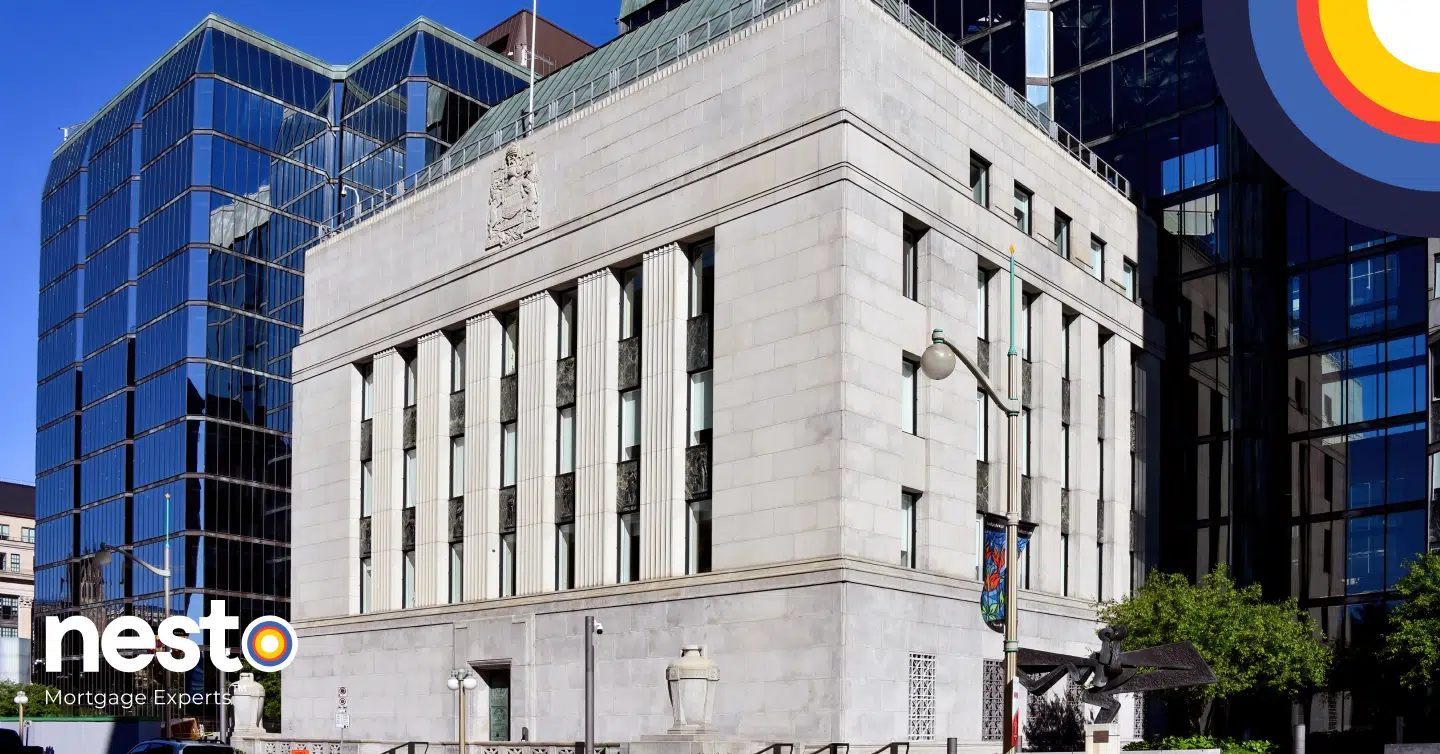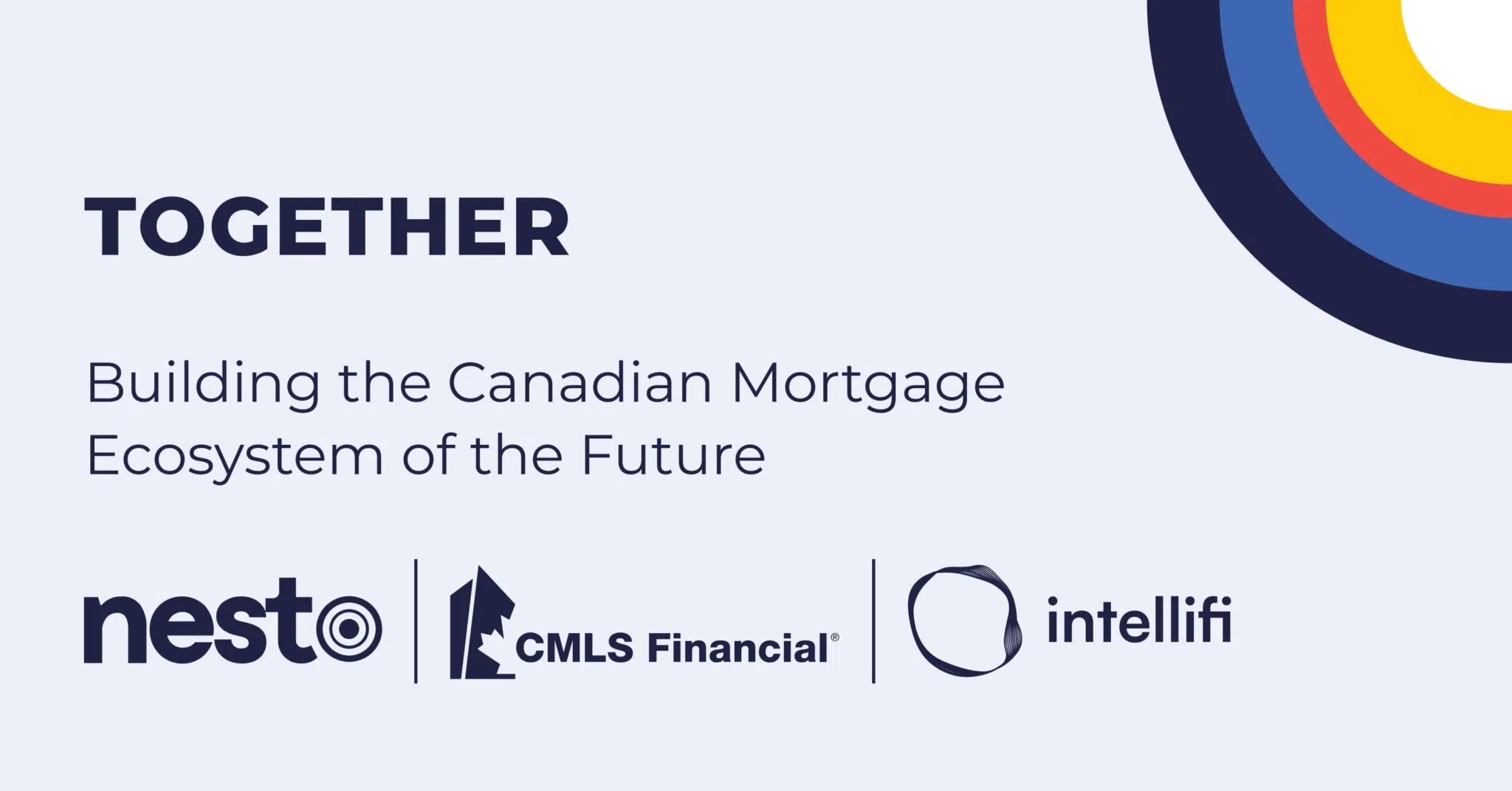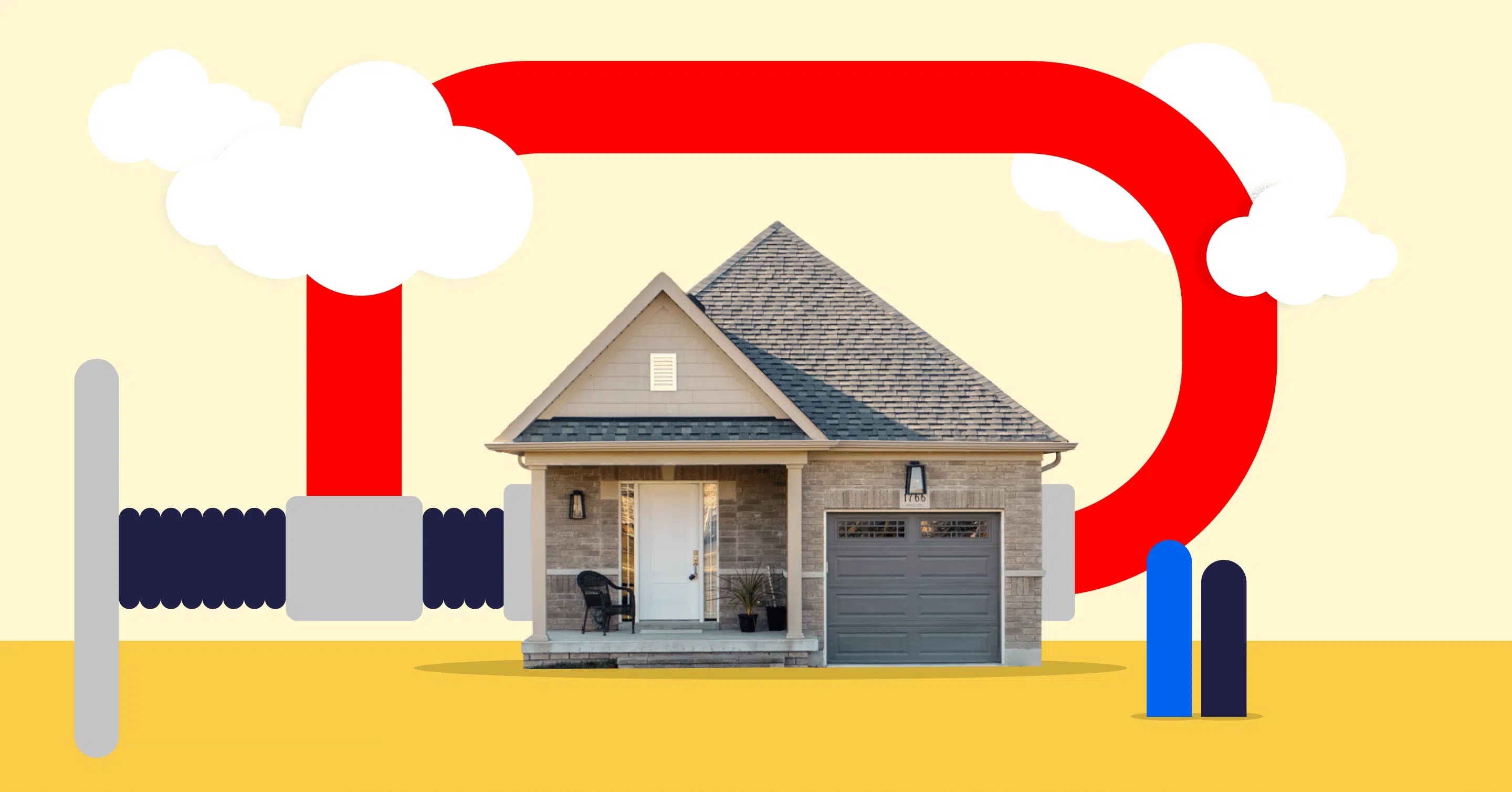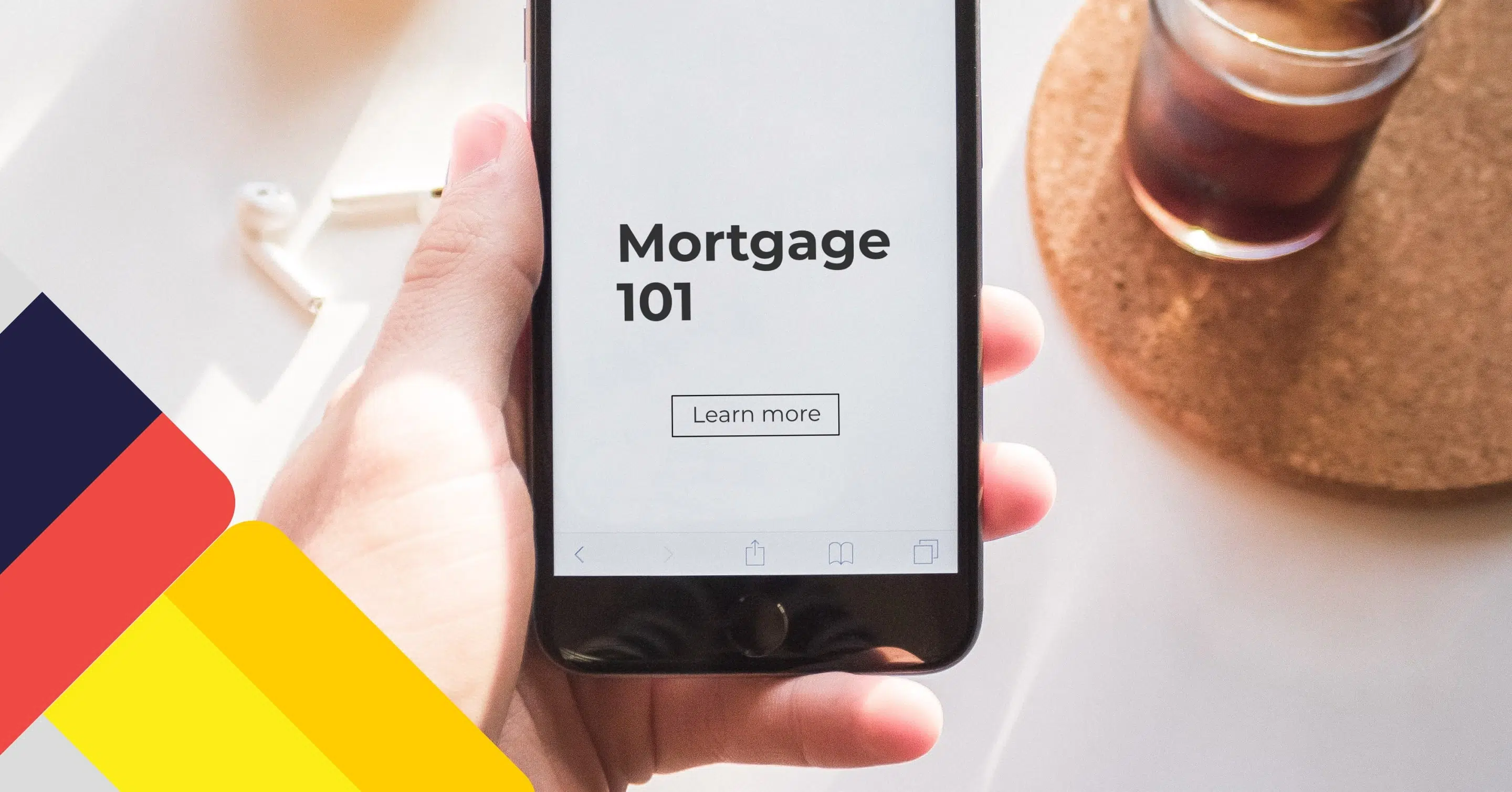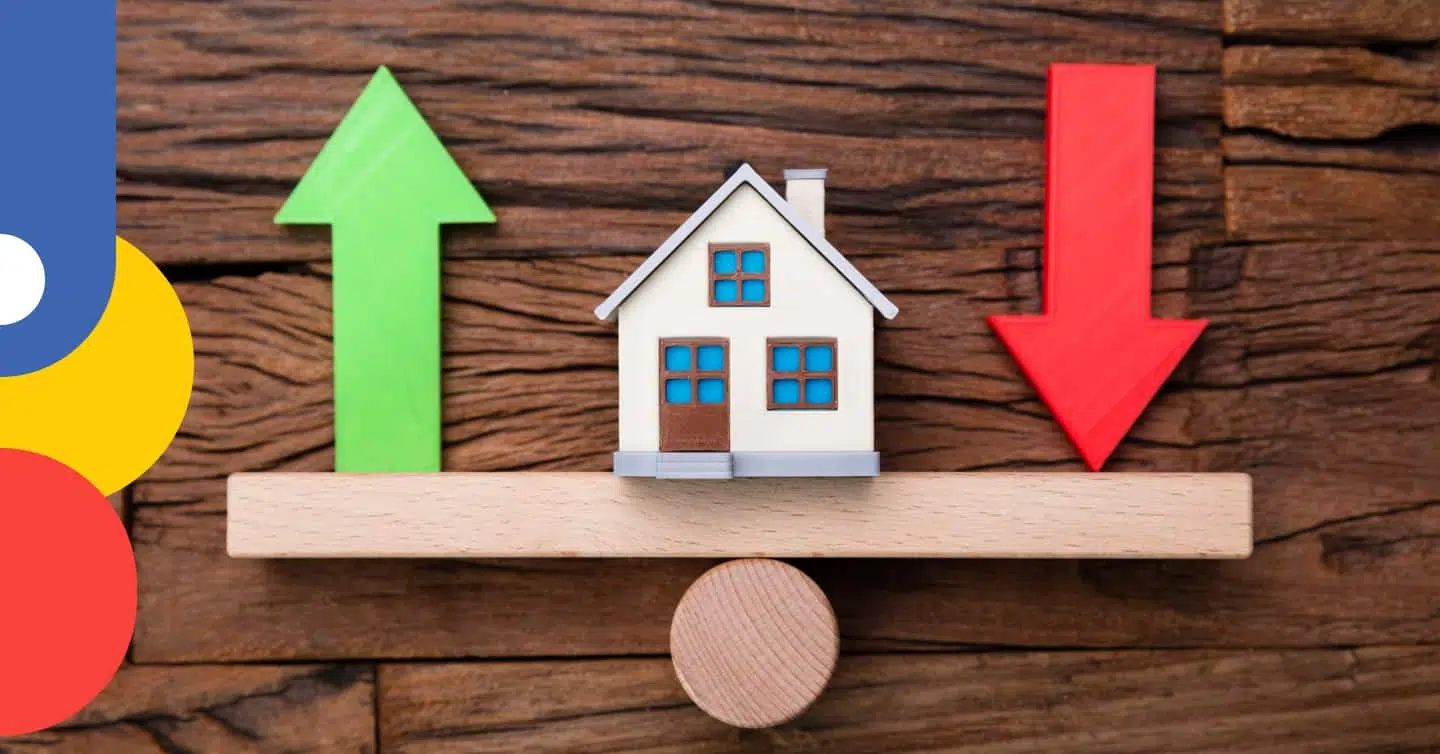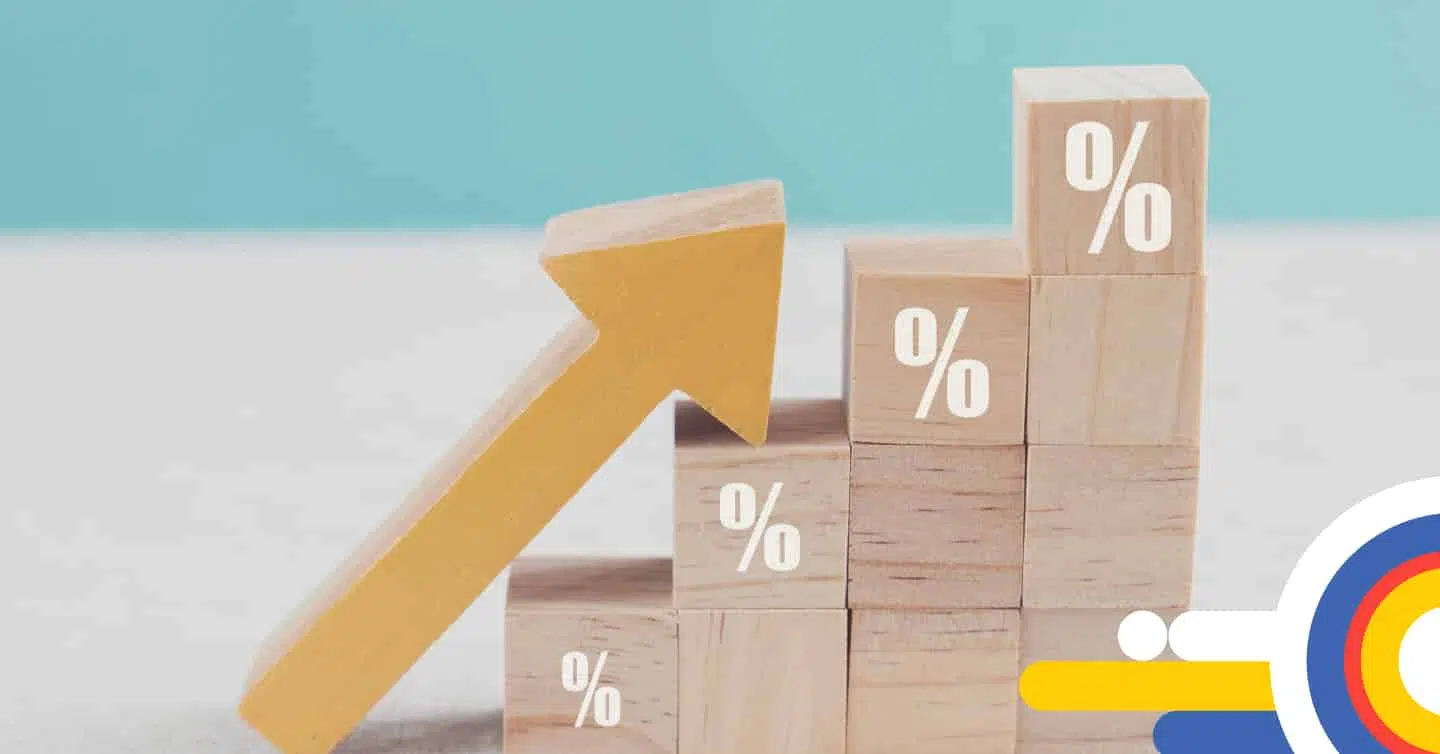| Mortgage Amount | Monthly Payment | 0.10% Reduction | 0.25% Reduction | 0.50% Reduction |
|---|---|---|---|---|
| $100,000 | $547.06 | $541.36 | $532.88 | $518.92 |
| $200,000 | $1,094.11 | $1,082.72 | $1,065.76 | $1,037.83 |
| $300,000 | $1,641.16 | $1,624.08 | $1,598.64 | $1,556.74 |
| $400,000 | $2,188.21 | $2,165.43 | $2,131.52 | $2,075.65 |
| $500,000 | $2,735.26 | $2,706.79 | $2,664.40 | $2,594.56 |
| $600,000 | $3,282.31 | $3,248.15 | $3,197.28 | $3,113.48 |
| $700,000 | $3,829.36 | $3,789.51 | $3,730.16 | $3,632.39 |
| $800,000 | $4,376.41 | $4,330.86 | $4,263.04 | $4,151.30 |
| $900,000 | $4,923.46 | $4,872.22 | $4,795.92 | $4,670.21 |
| $1,000,000 | $5,470.51 | $5,413.58 | $5,328.80 | $5,189.12 |
Today’s Mortgage Interest Rate in Canada
For Wednesday, July 2, 2025:
Canada’s average 3-year fixed conventional mortgage rates are
Canada’s average 3-year conventional mortgage rates for variable and adjustable mortgages are
Canada’s average 5-year conventional fixed mortgage rates are
Canada’s average 5-year conventional mortgage rates for variable and adjustable mortgages are
1 basis point is 1/100 of a percentage point, equaling 0.01%.
What are the average mortgage rates in Canada today?
As of Wednesday, July 2, 2025, the best conventional mortgage rates—available to borrowers with a down payment of 20% or more—tend to be slightly higher than insured rates but offer greater flexibility and eliminate default insurance premiums.
Below are the current average conventional mortgage rates available across Canada, including in Ontario, Québec, British Columbia, and Alberta:
- 2-year fixed conventional mortgage rate:
5.09% - 3-year fixed conventional mortgage rate:
4.69% - 3-year variable conventional mortgage rate:
5.50% - 4-year fixed conventional mortgage rate:
5.22% - 5-year fixed conventional mortgage rate:
4.58% - 5-year variable conventional mortgage rate:
4.67% - 7-year fixed conventional mortgage rate:
5.82% - 10-year fixed conventional mortgage rate:
6.78%
What is the lowest mortgage rate in Canada today?
As of Wednesday, July 2, 2025, the best high-ratio mortgage rates—available to borrowers with a down payment of less than 20%—are typically the lowest rates offered in Canada.
Below insured mortgage rates are available across Canada, including in Ontario, Québec, British Columbia, and Alberta:
- 2-year fixed insured mortgage rate:
- 3-year fixed insured mortgage rate:
- 3-year variable insured mortgage rate:
- 4-year fixed insured mortgage rate:
- 5-year variable insured mortgage rate:
- 5-year variable insured mortgage rate:
- 7-year fixed insured mortgage rate:
- 10-year fixed insured mortgage rate:
Qualified using nesto’s fixed and variable 5-year insured, insurable and uninsured rates as advertised on our mortgage rates page. For today, Wednesday, July 2, 2025, our example calculations are based on our lowest rates, which may or may not apply to your unique financing situation or long-term goals.
New insured fixed-rate mortgages (purchases) may be qualified at
New insured variable-rate mortgages (purchases) may be qualified at
All insurable fixed-rate mortgages (purchases) may be qualified at
As contractually insured and uninsured transfers from Federally Regulated Financial Institutions no longer need to be stress tested, they may qualify at their contract rate. However, we’ll continue to stress-test all mortgage income requirements for illustration purposes. Nesto’s mortgage pricing is dynamic, meaning that our insurable mortgage rates are based on the loan-to-value (LTV) ratio. Our mortgage rates are constantly changing, even intra-day, with pricing updates from investors behind each of our mortgage offerings. Calculations presented in our blogs and webpages are for information and learning purposes only, as they are made using rates that are updated more infrequently and may not reflect daily changes to our mortgage rates.
Canada’s average 2-year conventional fixed mortgage interest rates are [b6b_fixed_2_bp_week] since last week and now stand at
Canada’s average 2-year conventional interest variable and adjustable mortgages are [b6b_variable_2_bp_week] since last week and now stand at [b6b_variable_2]. Compared to a month ago, these rates are [b6b_variable_2_bp_month].
What is the average 2-year fixed conventional mortgage rate in Canada today?
The average 2-year fixed conventional mortgage rate is
What is the lowest 2-year fixed insured mortgage rate in Canada today?
The lowest 2-year fixed insured mortgage rate is
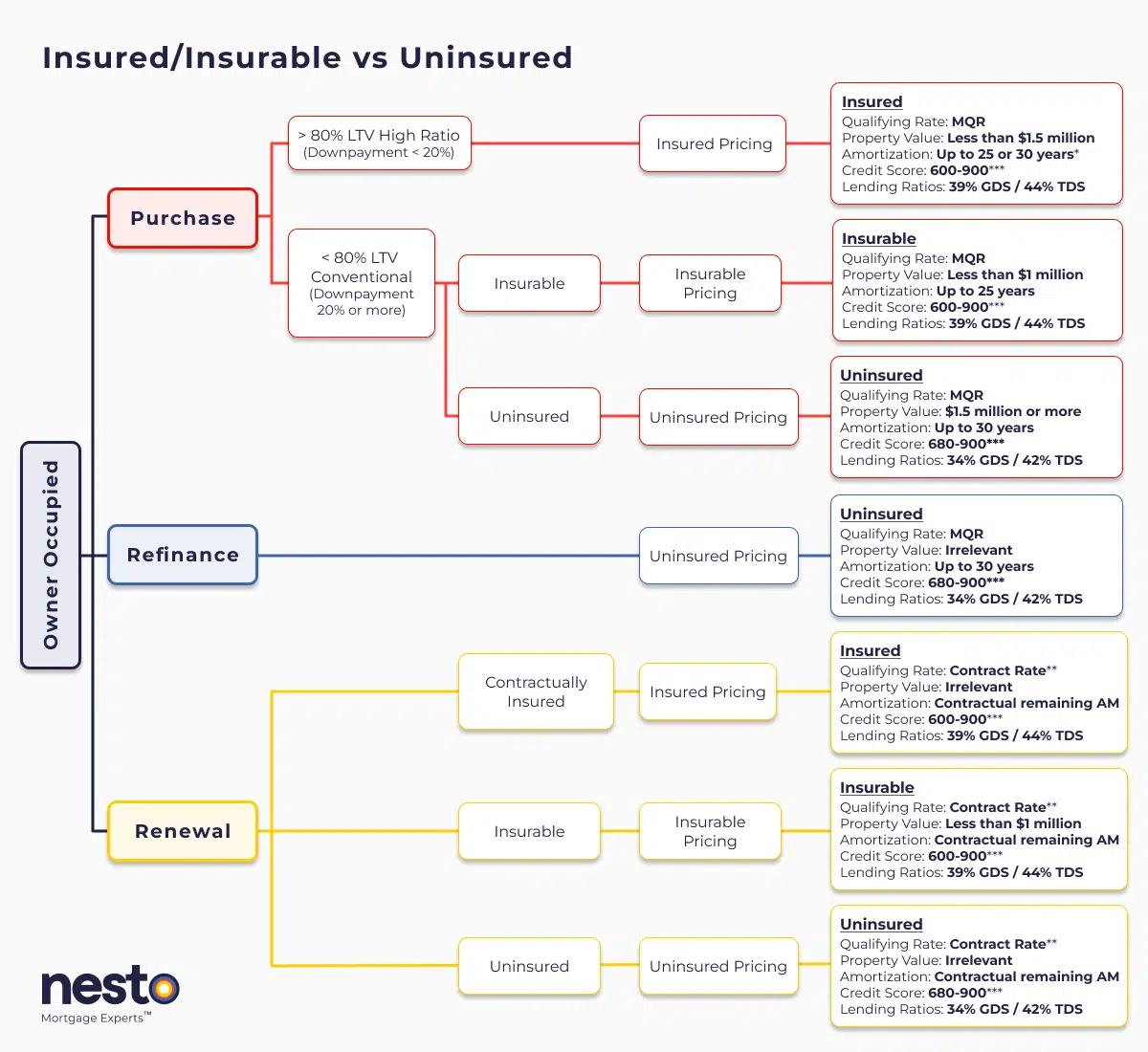
Details
*30-year amortizations on insured purchases are limited to first-time homebuyers (FTHBs) or anyone purchasing newly built homes.
**Qualified at contract rate at renewal only if there are no increases to contractually remaining amortization or remaining balance, and the mortgage is being transferred from a federally regulated lender as outlined by the Department of Finance (DOF) as a straight switch. The Minimum Qualifying Rate (MQR) requirements have been amended by the Office of the Superintendent for Financial Institutions (OSFI). It will be used to qualify all mortgages used for purchases and refinances. The MQR does not apply to renewals if the mortgage is renewed with the current lender or switched from a federally regulated lender.
***A credit score of 600 or 650 is allowable based on the mortgage insurer, and if there is a secondary applicant with a credit score of 680 or above. Lenders may scale debt service ratios (GDS/TDS) based on applicant(s) credit score(s) or reason for purchase/renewal (primary residence vs rental property). If one applicant on a joint mortgage has a credit score below 680, the lender may apply lending ratios as low as 32% GDS and 40% TDS. All criteria in the chart above apply to an owner-occupied primary residence mortgage with nesto.
Contractually insured mortgages are initially mortgage default insured by the borrower at the time of purchase and have not been refinanced or changed in any way that increases their remaining contractual amortization or mortgage balance. These insured mortgages are also known as high-ratio mortgages. In contrast, insurable and uninsured terms apply to conventional mortgages that are back-end bulk portfolio insured (typically lender-paid) or not.
New Purchase Qualifying Rates
Insured home purchases may be qualified using our lowest fixed rate, which will be the greater of 5.25% or
Insured home purchases may be qualified using our lowest variable rate, which will be the greater of 5.25% or
Insurable home purchases may be qualified using our lowest fixed rate, which will be the greater of 5.25% or
Insurable home purchases may be qualified using our lowest variable rate, which will be the greater of 5.25% or
Uninsured home purchases may be qualified using our lowest fixed rate, which will be the greater of 5.25% or
Uninsured home purchases may be qualified using our lowest variable rate, which will the greater of 5.25% or
Renewal (Switch or Transfer) Qualifying Rates
An insured mortgage may be qualified for renewal using the contract rate, which could be on our lowest fixed or variable insured rates, currently at
An insurable mortgage may be qualified for renewal using the contract rate, which could be on our lowest fixed or variable insurable rates, currently at
An uninsured mortgage may be qualified for renewal using the contract rate, which could be on our lowest fixed or variable uninsured rates, currently at
$701,800
decreased
decreased
3.5%
0.1%
$779,600
decreased
decreased
3.3%
0.1%
$643,000
decreased
decreased
4.0%
0.2%
$500,300
decreased
decreased
4.7%
0.2%
37,626
decreased
increased
0.5%
3.6%
78,980
increased
increased
9.0%
3.1%
48%
balanced market
decreased
increased
8.7%
0.5%
$2,118
decreased
2.3%
$1,614
decreased
0.8%
$1,902
decreased
2.9%
$2,299
decreased
3.9%
$2,755
increased
3.4%
[canada_composite_price_this_month]
[canada_composite_price_last_month]
[canada_composite_price_last_year]
[canada_lowest_mortgage_payment]
[canada_highest_mortgage_payment]
[canada_lowest_income_needed]
[canada_highest_income_needed]
[canada_lowest_income_needed_hourly_wage]
[canada_highest_income_needed_hourly_wage]
[canada_lowest_income_needed_rent_buy]
[canada_highest_income_needed_rent_buy]
[canada_mortgage_payment_insured_fixed_25]
[canada_mortgage_payment_insured_fixed_30]
[canada_mortgage_payment_insurable_fixed_25]
[canada_mortgage_payment_uninsured_fixed_25]
[canada_mortgage_payment_uninsured_fixed_30]
[canada_mortgage_payment_insured_variable_25]
[canada_mortgage_payment_insured_variable_30]
[canada_mortgage_payment_insurable_variable_25]
[canada_mortgage_payment_uninsured_variable_25]
[canada_mortgage_payment_uninsured_variable_30]
[canada_mortgage_payment_insured_fixed_25_last_month]
[canada_mortgage_payment_insured_fixed_30_last_month]
[canada_mortgage_payment_insurable_fixed_25_last_month]
[canada_mortgage_payment_uninsured_fixed_25_last_month]
[canada_mortgage_payment_uninsured_fixed_30_last_month]
[canada_mortgage_payment_insured_variable_25_last_month]
[canada_mortgage_payment_insured_variable_30_last_month]
[canada_mortgage_payment_insurable_variable_25_last_month]
[canada_mortgage_payment_uninsured_variable_25_last_month]
[canada_mortgage_payment_uninsured_variable_30_last_month]
[canada_mortgage_payment_insured_fixed_25_last_year]
[canada_mortgage_payment_insured_fixed_30_last_year]
[canada_mortgage_payment_insurable_fixed_25_last_year]
[canada_mortgage_payment_uninsured_fixed_25_last_year]
[canada_mortgage_payment_uninsured_fixed_30_last_year]
[canada_mortgage_payment_insured_variable_25_last_year]
[canada_mortgage_payment_insured_variable_30_last_year]
[canada_mortgage_payment_insurable_variable_25_last_year]
[canada_mortgage_payment_uninsured_variable_25_last_year]
[canada_mortgage_payment_uninsured_variable_30_last_year]
[canada_term_interest_insured_fixed_25]
[canada_term_interest_insured_fixed_30]
[canada_term_interest_insurable_fixed_25]
[canada_term_interest_uninsured_fixed_25]
[canada_term_interest_uninsured_fixed_30]
[canada_term_interest_insured_variable_25]
[canada_term_interest_insured_variable_30]
[canada_term_interest_insurable_variable_25]
[canada_term_interest_uninsured_variable_25]
[canada_term_interest_uninsured_variable_30]
[canada_term_interest_insured_fixed_25_last_month]
[canada_term_interest_insured_fixed_30_last_month]
[canada_term_interest_insurable_fixed_25_last_month]
[canada_term_interest_uninsured_fixed_25_last_month]
[canada_term_interest_uninsured_fixed_30_last_month]
[canada_term_interest_insured_variable_25_last_month]
[canada_term_interest_insured_variable_30_last_month]
[canada_term_interest_insurable_variable_25_last_month]
[canada_term_interest_uninsured_variable_25_last_month]
[canada_term_interest_uninsured_variable_30_last_month]
[canada_term_interest_insured_fixed_25_last_year]
[canada_term_interest_insured_fixed_30_last_year]
[canada_term_interest_insurable_fixed_25_last_year]
[canada_term_interest_uninsured_fixed_25_last_year]
[canada_term_interest_uninsured_fixed_30_last_year]
[canada_term_interest_insured_variable_25_last_year]
[canada_term_interest_insured_variable_30_last_year]
[canada_term_interest_insurable_variable_25_last_year]
[canada_term_interest_uninsured_variable_25_last_year]
[canada_term_interest_uninsured_variable_30_last_year]
[canada_income_needed_insured_fixed_25]
[canada_income_needed_insured_fixed_25_q]
[canada_income_needed_insured_variable_25]
[canada_income_needed_insured_variable_25_q]
[canada_income_needed_insured_fixed_30]
[canada_income_needed_insured_fixed_30_q]
[canada_income_needed_insured_variable_30]
[canada_income_needed_insured_variable_30_q]
[canada_income_needed_insurable_fixed]
[canada_income_needed_insurable_fixed_q]
[canada_income_needed_insurable_variable]
[canada_income_needed_insurable_variable_q]
[canada_income_needed_uninsured_fixed_25]
[canada_income_needed_uninsured_fixed_25_q]
[canada_income_needed_uninsured_variable_25]
[canada_income_needed_uninsured_variable_25_q]
[canada_income_needed_uninsured_fixed_30]
[canada_income_needed_uninsured_fixed_30_q]
[canada_income_needed_uninsured_variable_30]
[canada_income_needed_uninsured_variable_30_q]
[canada_income_needed_insured_fixed_25_last_year]
[canada_income_needed_insured_fixed_25_q_last_year]
[canada_income_needed_insured_variable_25_last_year]
[canada_income_needed_insured_variable_25_q_last_year]
[canada_income_needed_insured_fixed_30_last_year]
[canada_income_needed_insured_fixed_30_q_last_year]
[canada_income_needed_insured_variable_30_last_year]
[canada_income_needed_insured_variable_30_q_last_year]
[canada_income_needed_insurable_fixed_last_year]
[canada_income_needed_insurable_fixed_q_last_year]
[canada_income_needed_insurable_variable_last_year]
[canada_income_needed_insurable_variable_q_last_year]
[canada_income_needed_uninsured_fixed_25_last_year]
[canada_income_needed_uninsured_fixed_25_q_last_year]
[canada_income_needed_uninsured_variable_25_last_year]
[canada_income_needed_uninsured_variable_25_q_last_year]
[canada_income_needed_uninsured_fixed_30_last_year]
[canada_income_needed_uninsured_fixed_30_q_last_year]
[canada_income_needed_uninsured_variable_30_last_year]
[canada_income_needed_uninsured_variable_30_last_year_q]
Insured Fixed 25
Insured Variable 25
Insured Fixed 30
Insured Variable 30
Insurable Fixed 25
Insurable Variable 25
Uninsured Fixed 25
Uninsured Variable 25
Uninsured Fixed 30
Uninsured Variable 30
Income Needed to Get a $100,000 Mortgage
Getting a $100,000 mortgage in Canada might seem straightforward, but understanding the financial and affordability requirements can make a big difference. Factors like income, down payment, and interest rates all affect eligibility. This guide simplifies the process and offers practical tips to help you qualify for a $100,000 mortgage.
Key Takeaways
- On a $100,000 mortgage at nesto, your monthly payment will range between $487.71 and $564.39.
- Depending on your down payment and debts, a gross annual income between $24,713.31 and $31,368.59 is typically needed for a $100,000 mortgage.
- You’ll need to earn between $11.88 and $15.08 hourly to qualify for $100,000 at today’s low rates at nesto.
How Much Income Do You Need for a $100,000 Mortgage?
Lenders calculate your mortgage affordability based on your Gross Debt Service (GDS) and Total Debt Service (TDS) ratios:
- GDS Ratio: You should not exceed 39% of your gross monthly income on insured and insurable mortgages or 34% for uninsured mortgages.
- TDS Ratio: You should stay below 44% of your gross monthly income or 42% on uninsured mortgages.
The following two examples showcase calculations for the lowest and highest income needed to qualify for a $100,000 mortgage with an insured mortgage on a 25-year amortization and an uninsured mortgage on a 30-year amortization.
Here’s an example of a home valued at $111,111 with an insured mortgage on nesto’s fixed rate:
- Down Payment: With a 10% down payment ($11,111), the mortgage amount would be $100,000.
- Additional Costs affecting debt ratios: Estimated monthly heating costs at $100 and property taxes at 1% annually.
- Income Needed: The income needed to qualify for a $100,000 insured mortgage is approximately $26,110, based on a 5-year fixed rate of
over 25 years.
Here’s an example of a home valued at $125,00 with an uninsured mortgage on nesto’s fixed rate:
- Down Payment: With a 20% down payment ($25,000), the mortgage amount would be $100,000.
- Additional Costs: Estimated monthly heating costs at $100 and property taxes at 1% annually.
- Income Needed: The income needed to qualify for a $100,000 uninsured mortgage is approximately $29,179, based on a 5-year fixed rate of
over 30 years.
For these scenarios, while a monthly mortgage payment ranges between, the gross annual income required for this mortgage ranges between $24,713.31 and $31,368.59 would meet GDS and TDS limits.
Affordability Factors for a $100,000 Mortgage
- Interest Rates: Lower rates mean smaller monthly payments, reducing the income needed. Shop around for competitive rates.
- Down Payment Size: A higher down payment lowers your mortgage amount and can eliminate the need for mortgage insurance.
- Debt Levels: High consumer debt can impact your TDS ratio, reducing the amount you qualify for.
How to Improve Your Mortgage Affordability
- Save for a Bigger Down Payment: Reducing your loan size lowers monthly payments.
- Pay Down Existing Debts: Reducing consumer debt improves your TDS ratio.
- Boost Your Credit Score: A higher score may help you qualify for better rates.
- Extend the Amortisation Period: Stretching payments over 30 years reduces monthly costs (if offered by your lender).
Comparing Renting vs Buying with a $100,000 Mortgage
When deciding whether to rent or buy a home, the 5% rule is a helpful guideline for comparing homeownership costs against renting. This rule suggests that a home’s total annual carrying costs—excluding mortgage payments—should be approximately 5% of the home’s value. These include property taxes, maintenance, and opportunity costs (the return you forgo by investing in real estate instead of other assets). Using this rule, you can estimate if buying a home with a $100,000 mortgage is financially favourable compared to renting.
For an insured purchase with a 10% down payment and a 25-year amortization, the total home value would be about $111,111 ($100,000 mortgage + $11,111 down payment). Using the 5% rule, the annual carrying cost would be approximately $5,556 ($111,111 × 5%), or around $463 monthly. With mortgage payments included, assuming an interest rate of
For an uninsured mortgage with a 20% down payment and a 30-year amortization, the home value would be around $125,000 ($100,000 mortgage + $25,000 down payment). Applying the 5% rule, the estimated annual carrying cost would be $6,250, or about $520 monthly. Factoring in mortgage payments at an
Frequently Asked Questions
How much is the minimum down payment for a $100,000 home?
The minimum down payment is 5%, or $5,000, if your mortgage is insured.
Can I get a $100,000 mortgage with bad credit?
It may be challenging, but improving your credit score and reducing debt can increase your chances. Some alternative lenders may have more flexible requirements.
How does mortgage insurance affect my payment?
Mortgage insurance premiums typically range from 2.8% to 4% of your mortgage amount but can go up to 4.20% for first-time home buyers (FTHB) or those purchasing a newly built home with an insured mortgage and a 30-year amortization. These premiums increase your monthly payments. Mortgage insurance is mandatory for down payments of less than 20%, but borrowers can choose to pay the premium upfront in cash instead of adding it to the mortgage balance, helping to avoid additional interest costs over time.
What would my mortgage payment be on a $100,000 mortgage?
Your mortgage payment depends on your interest rate and amortization. Depending on your preferred mortgage solution and amortization chosen, your mortgage payment at nesto will range between $487.71 and $564.39 monthly.At nesto’s current insured 5-year fixed rate of
How much would I need to make per hour to afford a $100,000 mortgage?
Assuming 40-hour workweeks, you’d need an hourly wage of between $11.88 and $15.08 to meet the required annual income range.
Conclusion
Securing a $100,000 mortgage in Canada requires a clear understanding of income requirements and affordability factors. However, managing debts, saving for a larger down payment, and choosing the right mortgage type can make homeownership more accessible.
Ready to take the next step? Contact nesto mortgage experts for personalized advice and the best rates to help you achieve your dream of homeownership.
Big 6 Average Validation
b6b_fixed_3 =
b6b_variable_3 =
b6b_fixed_5 =
b6b_variable_5 =
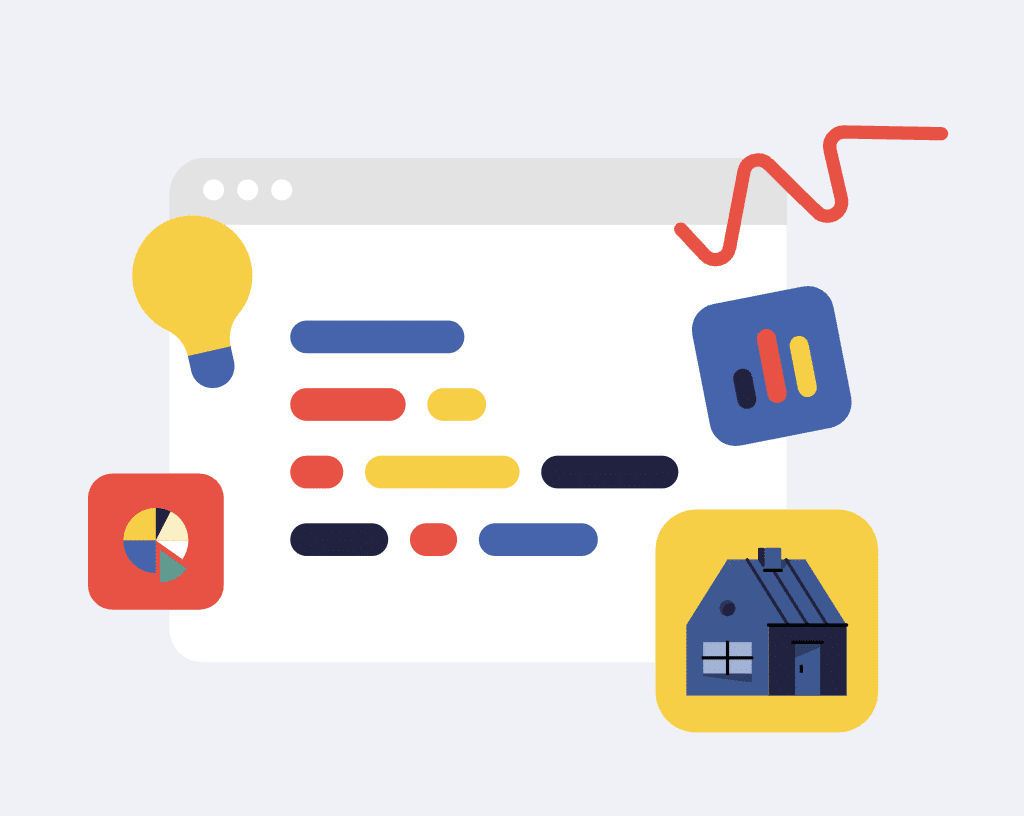

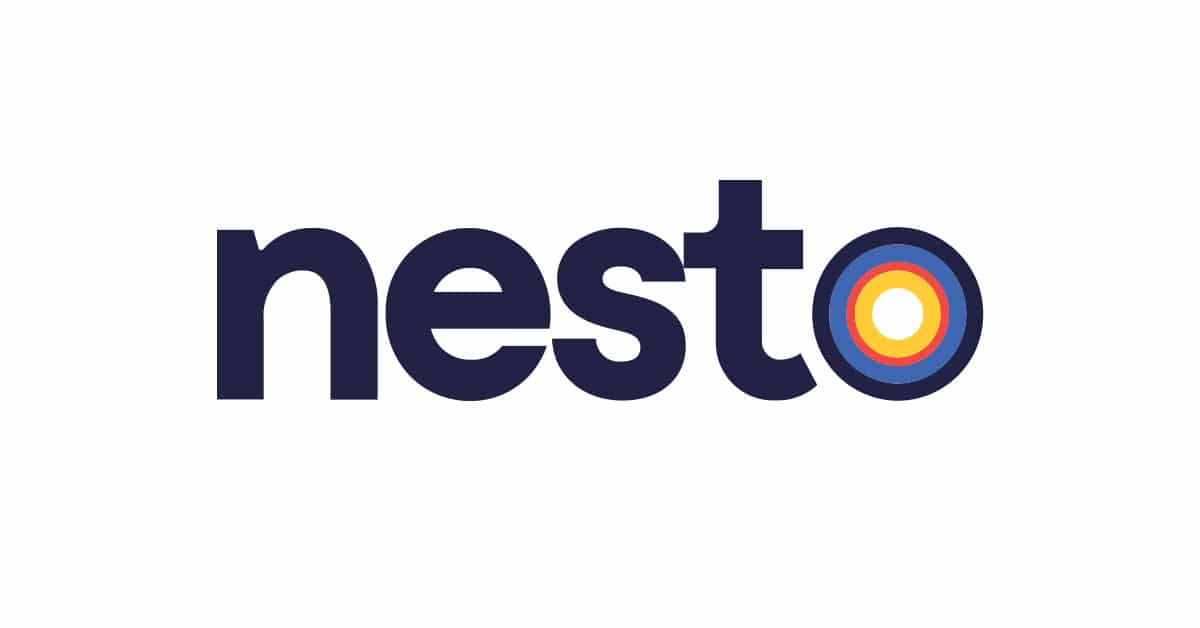
Factors That Influence Your Mortgage Rate in Canada
Factors such as credit score, income, down payment, and the purpose of the loan determine how your mortgage rate is priced.
Mortgage rates in Canada vary depending on different factors such as the borrower’s credit, the property being used as collateral, the borrower’s income capacity to service the debt, the borrower’s capital in the form of savings/investments and down payment, and most importantly, conditions. Conditions such as the purpose of the loan and the loan-to-value (LTV) ratio – these two conditions will have the most impact on the rate. The mortgage rate is priced based on the risk associated with that mortgage, property and borrower.
The lowest rate is not essential to getting a mortgage that will save you the most interest. Sometimes, the lowest rate is the “no frills” or “restricted” or “limited” mortgage that a lender offers. Beyond not having a high rate, these mortgages don’t have any prepayment privileges or other features such as portability or assumability.
Mortgage Term
Your mortgage term is when your mortgage agreement and rate will be in effect. Mortgage terms range from 6 months to 10 years, with 5 years being the most common term. But, just because 5 years is the most common doesn’t mean it’s right for you. Like the mortgage, choosing the term depends on your needs and goals.
A mortgage term is one of the criteria lenders use to price mortgages, so comparing pricing based on rate alone doesn’t make sense without deliberating on the correct term that best suits your needs. We recommend you have a mortgage assessment discussion with your mortgage professional to understand the most suitable solution for your unique borrowing situation
Mortgage Type
The type of mortgage you select will play the biggest role in your mortgage rate. Mortgage types such as adjustable, variable, fixed, open, closed, standard charge or revolving home equity lines of credit (HELOCs) under a collateral charge are all personal choices based on your unique financial planning needs.
Open Mortgages vs. Closed Mortgages
When comparing open versus closed mortgages, for instance, it’s important to note that open mortgages are priced higher because they offer the flexibility to pay the mortgage off at any time without facing a penalty.
Variable Rate Mortgages (VRM) vs. Adjustable Rate Mortgages (ARM)
There are two types of variable-rate mortgages: those with static payments and those with variable or fluctuating payments. Static-payment variable-rate mortgages are more specifically called variable-rate mortgages (VRM); variable-rate mortgages with a variable payment, in which the payment adjusts with changes in the lender’s prime rate, are more accurately called adjustable-rate mortgages (ARM). Commonly, they are both known as variable-rate mortgages.
Mortgage Down Payment
The down payment size will determine your loan-to-value (LTV) ratio and whether you must also purchase mortgage default insurance. LTV is most important to mortgage rate pricing with insured or insurable lending criteria.
Insured Mortgages vs Insurable Mortgages
Insured and insurable mortgage rate pricing applies on properties valued at less than $1 million; the amortization is up to 25 years. In such cases, the lender will provide a better rate as there is a lower risk of loss.
The borrower would purchase the insurance on the front end in the case of an insured purchase with less than a 20% down payment. To give you a lower rate, lenders can also purchase the insurance on the back end to lower the default risk on the mortgage if your down payment is more than 20%.
An insured mortgage is qualified as such when your down payment is less than 20%. Therefore, you will need to purchase high-ratio default insurance. Although this insurance can be added to your mortgage, the taxes (PST) on purchasing this insurance are not.
Provincial Sales Tax on Mortgage Default Insurance
Upon your closing, your solicitor will collect and remit the PST on behalf of the high ratio insurer (CMHC, Sagen or Canada Guaranty). Once the high ratio default insurance is purchased from one of the three default insurers, the risk to the lender is reduced as the default insurance will protect them in case of default.
All things being equal, the lowest rate, in this case, will be an insured purchase or insured transfer, where default insurance was purchased with the home by the borrower.
The Cost of Default Insurance to the Lender affects your Mortgage Rate
Second, there is an insurable criterion with mortgage finance companies that do not exist with large banks. If you put down 20% or more with a purchase price of less than $1 million having an amortization of up to 25 years, then your mortgage will be priced based on an insurable sliding scale – meaning the more down payment, the lower the mortgage interest rate.
The second-best rate applies to purchases and renewals with 35% or more equity or down payment – meaning 65% loan-to-value (LTV) will get you the second-best mortgage rate. This is because the lender will buy the default insurance on the back end, and the cost is insignificant, with 35% or more equity. The rate increases until the worst pricing occurs at exactly 80% LTV with 20% equity or down payment.
Uninsured Mortgages
Lastly, the mortgage price is highest for an uninsured mortgage, which means that either the amortization is higher than 25 years or the property purchase price is more than $1 million. In this case, the mortgage is uninsured, meaning you cannot purchase default insurance, meaning all the risk has defaulted back to the lender. The lender will price the mortgage rate higher than any other criteria for this higher-risk type.
Property Use
If you’re buying a home you intend to live in, this is considered your primary residence and will be known as owner-occupied. If you’re buying an investment property you intend to rent to others, you’ll pay higher interest rates than your primary residence. Or suppose you purchase a primary residence with a second separate legally registered suite. In that case, it is considered an owner-occupied rental, and you’ll have access to the lowest rates similar to those offered on a primary residence.
The logic behind your higher rate for a mortgage on a property solely for investment purposes is if money is tight, people will pay the mortgage on their primary residence before other obligations. As such, lenders build added risk into the rates for rental properties.
Transaction Type
Mortgages are priced very much the same for purchases and renewals based on the loan-to-value (LTV) ratio and other factors that influence rates, such as whether the transaction is insured or insurable.
Mortgage Refinances and Uninsured Purchases & Renewals
Refinances are considered uninsured transactions and, therefore, carry higher risks. Lenders price the higher risk based on the number of exceptions to their policy they will make in exchange for the risk they are taking with a specific mortgage.
Refinances can occur for many reasons. Extending your mortgage balance or amortization would be considered a refinance. Changing a mortgage covenant, such as adding or removing someone from the property’s land title, would be considered a refinance. Adding a HELOC by changing the registered charge on the property would be considered a refinance. Combining a HELOC and mortgage separately mortgaged on the same property’s title but with different lenders will be considered a refinance. Combining two separately registered collateral charges on the same property may be considered a refinance. Transferring a mortgage to a prime (A) lender from an alternative (B or private) lender will be considered a refinance.
Converting or Transferring a Mortgage
Mortgage conversion and porting are other transactions priced without simple, straightforward rules. When you convert a variable mortgage, either VRM or ARM, into a fixed-rate mortgage, it is called conversion, also known as an early renewal.
The lender will not give any discounts on their posted rates if you convert your variable rate into a fixed mortgage rate, as they would for acquiring new business. Any term remaining less than 5 years may be converted to keep the remaining term the same or increase the term to 5 years. This same logic applies to the early renewal of a fixed-rate mortgage.
Mortgage Portability
With mortgage portability, a lender gives you 30 to 90 days from the time it is paid out at the sale of the current property to transfer your mortgage to a new property. The lender will refund the prepayment penalty once the new mortgage is closed and your current rate is transferred.
If the required mortgage you need is higher than the balance you paid out on the old mortgage, then the lender must provide you with a weighted average rate. In this case, the new rate is weighted concerning the balances based on the old rate, the mortgage paid out and ported, and the new rate based on current prevailing market rates.
Amortization
The amortization period cannot exceed 30 years on the prime lending side. The maximum allowable amortization is 25 years on mortgages with less than a 20% down payment or equity in the property at the time of renewal. You can go up to 30yrs amortization on mortgages with down payments of 20% or more.
The longer the amortization, the lower your mortgage payment. The shorter your amortization period, the more money you save on interest over the term or life of the loan. The difference between two identical mortgages with different amortizations is the interest-carrying cost for the extended time the money is lent out.
Credit Score
There are multiple credit rating agencies and different types of scoring systems. The two main credit agencies prevalent in Canada are Equifax and TransUnion. They both provide different credit scores, one of which is the 3 years running score, also known as a soft credit check.
Both agencies will also provide a hard credit score, the whole life score for a borrower. The scoring is based on a total of 900. The hard credit score from Equifax, specifically known as FICO (previously called Beacon), is the credit scoring method used by mortgage lenders and professionals. FICO stands for Fair Isaac & Co, aptly named after the company that developed that scoring system.
Hard Credit Checks
A hard credit check on your credit bureau does not immediately reduce your credit score. The credit rating agency will know who pulls your credit score and why. Multiple mortgage brokers or lenders completing hard credit checks within 45 days will be grouped as only one credit hit by the credit rating agency. Some credit rating points will be deducted from your credit score, but those will be reinstated with your timely bill payments over a few quarters.
Soft Credit Checks
Soft credit checks do not affect your credit score and are great for planning. However, they don’t offer much assurance to a lender underwriting your mortgage application. At some point, the lender or broker must pull your FICO score to ensure you meet their requirements and check back on your full repayment history.
Lenders have a specific minimum FICO score requirement of 680 or 720 out of 900 to provide you with the best mortgage rate. Lenders will not want missed payments, especially for mortgage payments, as it will show to the lender either you have poor budgeting or cash flow or your monthly obligations and carrying costs exceed your income. Lenders and brokers will want to know if you put any practices in place to avoid any negative habits in the future.
Minimum Credit Requirement
The best rates, such as nesto’s, are reserved for borrowers with a FICO score of 680+ and no missed mortgage payments. Exceptions can be made in some circumstances, such as missed payments due to separation. During a separation, neither party could take responsibility for all the household payments, and due to unforeseen circumstances, the mortgage may have been neglected.
There is always a story, and nesto mortgage experts are willing to listen and understand the full story behind your credit report. If there is a reasonable explanation for missed payments, our mortgage expert will put a case together to ask for exceptions from the underwriting department on your behalf.
Canadian Income Proof
The stability of your income shows your capacity to carry the mortgage and any other debts, which show up as facilities on your credit bureau report. If your employment is new, your income must be established past probation. Changing employers in the middle of your mortgage financing is not advisable. Lenders will use a 2-year average on non-guaranteed income such as hourly, bonus, overtime, contract, or self-employed income.
Types of Income in Canada
On the A or Prime lending side, lenders can use your taxed income, but any forms of income that are not taxed will not be considered. Upon exception, up to 70% of non-taxed income could be used for qualification. If you change industries and don’t have two years of average income, the lender may average your year-to-date received income over two years to get a conservative value.
Canadian Income Documentation
Lenders will ask for various documents to satisfy their risk assessment. The main documents that borrowers may need to provide are paystubs, letters of employment, and T4s if they are employed. At a minimum, Business Registration or Articles of Incorporation, Notice of Assessments (NOAs), T1 Generals and 3 months of business/corporate/individual bank account histories are required for self-employed or incorporated individuals.
Going Beyond The Rate
When purchasing a home, many steps are involved in the mortgage process. This section will outline those steps and provide tips for successfully navigating them. The most important step is determining which mortgage is right for you. Taking the time to understand the various solutions and what each has to offer can ensure that you make sound decisions throughout the entire process and ultimately end up in the home of your dreams!
Should I choose the lender with the lowest rate?
The lowest rate is not always the best option for everyone. Depending on your short and long-term goals for owning your home, it may be wiser to choose the mortgage solution that works best for you. The best solution for you may not be the lowest rate option. As the mortgage rate is priced based on the risk the borrower represents for the lender, it may be best to review the restrictions attached.
There may be restrictions tied to a hefty penalty if the borrower pays out the loan before maturity. Restrictions can come in the form of features, benefits, and bigger penalties than the usual 3-month interest or interest rate differential.
When opting for the lowest-rate product, you may have to give up features such as prepayments or porting privileges. Without the ability to port, penalties on these types of lowest-rate mortgages can be quite daunting, such as a percentage of the mortgage balance at the time of payout.
Please speak to one of our commission-free mortgage experts. They can show you how to save even more with a full-feature mortgage by making small changes to your mortgage repayment plan.
What are mortgage prepayment options?
Prepayment privileges enable you to make extra payments directly to pay off your principal. Prepayment options come in many forms and have different limitations based on your lender, but overall if you choose to exercise them, they will save you time and money so you can become mortgage-free faster.
There are several ways you can take advantage of prepayments, including:
- Lump-sum payments – This option will come either in the form of one single lump sum up to 10%, 15%, or 20% either once in a year or once a year on the anniversary date of the mortgage; or very liberally you can make multiple lump sum payments throughout the year without exceeding the allowable amount.
- Double-up payments—This option lets you automate lump sum payments to double up and match your regularly scheduled payments. The savings will be exponential if you’re already on an accelerated payment plan.
- Increase regular payments – If you have any prepayment privileges with your mortgage, you will have a corresponding option for lump sum payments to increase your regular payments by the same percentage on the anniversary date.
- Payment frequency—This option lets you accelerate your weekly or biweekly payment. This means that the semi-monthly payment amount is applied 24 times a year and 26 times a year for biweekly accelerated payments. In contrast, weekly accelerated payments are half the semi-monthly amount applied 52 times yearly. Although technically not considered a prepayment privilege, accelerated payments can shave off a couple of years over the life of the mortgage.
Depending on the lender and the mortgage restrictions, not all prepayment privileges will be standard. Most lenders will have a full-featured mortgage that gives you all privileges and a restricted or limited-feature mortgage that gives you none. Some lenders will price a mortgage interest rate based on the number of features it provides, while others will use an a la carte approach in pricing each file individually.
nesto has some of the most simplified features available. We give you all options on our full-feature mortgages, including making a minimum lump sum for as little as $100 with any of your regularly scheduled payments.
Unlike our limited-feature mortgages, we may not offer prepayment privileges; however, the pricing is the same for all clients who qualify and get either of these mortgages. We prefer to have clients discuss their short- and long-term goals with our mortgage experts to ensure that their solution suits their unique needs, as not all mortgage solutions are suitable for everyone.
How do I compare mortgage rates in Canada?
When comparing mortgage rates in Canada, it’s important to look at similarities and differences between the comparable types and terms. Comparisons must be made with complementary solutions, meaning a fixed rate with another fixed rate and vice versa. The mortgage term must be aligned well – compare a 5-year term with a 5-year one.
Then you have to look beyond the rate, the features, benefits and restrictions. Many low-rate mortgages have restrictions – such as pre-emptive qualifying criteria and prepayment penalties that are outside of the normal if paid off or refinanced before the end of its term. Some restrictions go as far as to inhibit the ability to payout or renew early by adding a bona fide sale clause – meaning you can’t break the mortgage except to sell the property to an unrelated party.
What are Bank of Canada mortgage rates?
The Bank of Canada (BoC) doesn’t set Canadian mortgage rates. But it does impact them directly and indirectly. The Bank sets the benchmark overnight target for the Policy Rate, which directly impacts all the Prime Rates in Canada, also known as the Bankrate. When the economy is strong, the BoC could raise the Policy Rate to keep inflation from rising above its 2% target. Likewise, when the economy weakens, the Bank could lower the Policy Rate to keep inflation from falling below its 2% target.
The Policy Rate directly impacts all the prime rates in Canada, which in turn directly impacts all the variable mortgage rates in Canada. However, fixed mortgage rates are determined by Bond yields, which are priced and traded on the open market.
Bond yields can change direction based on market sentiment and economic factors like inflation and employment. While this won’t affect your mortgage interest rate if you’re already locked into a 5-year fixed mortgage rate, it can change bank’s interest rates on new 5-year fixed mortgages.
Canada Mortgage Stress Test
After the Great Recession in 2007, due to the mortgage market fallout in the US, the international community agreed to and mandated a set of mortgage underwriting guidelines to protect the world’s real estate. These rules are the B-20 Guidelines, mandated and legislated by the Office of the Superintendent of Financial Services (OSFI) in Canada.
As of October 2016, these guidelines slowly became different aspects of mandated rules governing prime mortgages in Canada. Canada already had rigorous mandates for its mortgage lenders, so our real estate was unaffected by the fallout south of the border.
One of the aspects of these guidelines is the mortgage stress test, with its first rule being implemented in October 2016. If you arranged your mortgage before October 2016 and have not refinanced it, you will not be impacted similarly by the stress test when you renew your mortgage with another lender.
Passing the Mortgage Stress Test
If you want the best rate, you’ll need to pass a stress test to qualify for a mortgage with a prime lender. You must prove you can afford payments at a qualifying interest rate typically higher than the actual rate in your mortgage contract.
You must pass this stress test to determine whether you require mortgage default insurance. Provincially regulated credit unions are not required to qualify all mortgages on the stress test; however, they will use a higher interest rate as they will not have access to prime lending rates on those mortgage solutions.
Federally regulated lenders such as mortgage finance companies and banks must use the higher interest rate of either:
- 5.25%
- the contracted interest rate plus 2%
On variable rate mortgages, both VRM and ARM, the rate you lock in during a pre-approval can change with the lender’s prime rate change. Indeed, the variable mortgage rate hold is a discount, which is being held from the lender’s prime rate, which fluctuates with the BoC’s Key Overnight Policy Rate.
If you already have a mortgage, you’ll need to pass this stress test if you:
- refinance (refi) your home for equity take out (ETO)
- Renew by transferring or switching to a new lender, or
- take out a home equity line of credit
What is the current stress test in Canada?
nesto’s Mortgage Stress Test Rates as of July 2, 2025
Stress Test Rate: The greater of the minimum qualifying rate and your mortgage rate + 2%
INSURED RATES
| LOWEST FIXED RATE | LOWEST VARIABLE RATE |
|---|---|
| Qualifying rate is | Qualifying rate is |
INSURABLE RATES
| LOWEST FIXED RATE | LOWEST VARIABLE RATE |
|---|---|
| Qualifying rate is | Qualifying rate is |
UNINSURED RATES
| LOWEST FIXED RATE | LOWEST VARIABLE RATE |
|---|---|
| Qualifying rate is | qualifying rate is |
Details
| Mortgage Insurability | Downpayment / Equity | Amortization & Property Value | Qualifying Criterion | Mortgage Qualifying Rate |
|---|---|---|---|---|
| Insured Purchase / Renewal | Less than 20% | Up to 25 years (or up to 30 years for FTHBs or those purchasing a newly built home) Less than $ 1.5 million | Greater of the benchmark MQR or contract Rate + 2% | Fixed at Variable at |
| Insurable Purchase / Renewal | 20% or more | Up to 25 years Less than $1 million | Greater of the benchmark MQR or contract Rate + 2% | Fixed at Variable at |
| Uninsured Purchase / Renewal / Refinance | 20% or more | Up to 30 years $1.5 million or more | Greater of the benchmark MQR or contract Rate + 2% | Fixed at Variable at |
Your mortgage qualifying rate (MQR) is the greater of 5.25% (also known as the benchmark minimum qualifying rate), or your mortgage contract rate + 2%. The Office of the Superintendent of Financial Institutions (OSFI) sets the mortgage qualifying criteria. Mortgage holders switching an insured, insurable, or uninsured mortgage from a federally regulated lender to a new lender at renewal can qualify at their contract rate.
Canadian Mortgage Lending Ratios
Mortgage lending ratios are the Gross Debt Service Ratio (GDSR) and Total Debt Service Ratio (TDSR). As the names suggest, GDSR calculates the household debt carrying capacity against an applicant’s qualified income, and TDSR calculates the total debt carrying capacity against a borrower’s income. On joint applications, ratios for qualifying are combined debt payments and incomes in the case of multiple borrowers.
Typically, insured or insurable transactions, where the purchase price or assessed value is under $1 million and the mortgage amortization is up to 25 years, will lend up to 39% on GDSR and 44% on TDSR. Some lenders will use different ratios due to their risk appetites.
Uninsured Transactions in Canada
Uninsured transactions are classified as purchases or renewals where a property is valued at more than $1 million, the amortization will be more than 25 years, or the transaction is a refinance – where equity is taken out or time is being extended.
In the case of uninsured transactions, lenders will have their risk assessment criteria to use whatever ratios they feel comfortable with based on the client’s unique situation. The lender can qualify the ratios and mortgage rate pricing on the file’s risk profile and lender’s risk appetite. The money they use to fund uninsured mortgages comes from their sources – instead of Canada’s mortgage bond market with its set of strict qualifying rules.
Calculating Your Debt Service Ratios
GDSR = (Mortgage Payment + Property Taxes + Condo Fees/2 + Hydro)/Income
TDSR = (All debts in GDSR calculation + all other debts) / Income
Initially, newer lenders will offer the best rates as they have to prove to the regulators and their investors their files are impeccable. As they fund more mortgages, their risk appetite will increase. They will provide more income and lending ratio exceptions, which may affect mortgage rate pricing on individually qualified files.
Pass Your Mortgage Stress Test
You must also pass a mortgage stress test to qualify for a certain mortgage amount. This stress test is essentially insurance that you’ll still be able to afford your mortgage payments if interest rates rise. This higher rate is known as the mortgage qualifying rate and is set by OFSI. All mortgage applications are subject to stress testing using the higher qualifying rate between the 5-year benchmark minimum qualifying rate (MQR) or the contractual mortgage rate (offered by your lender) plus 2%.
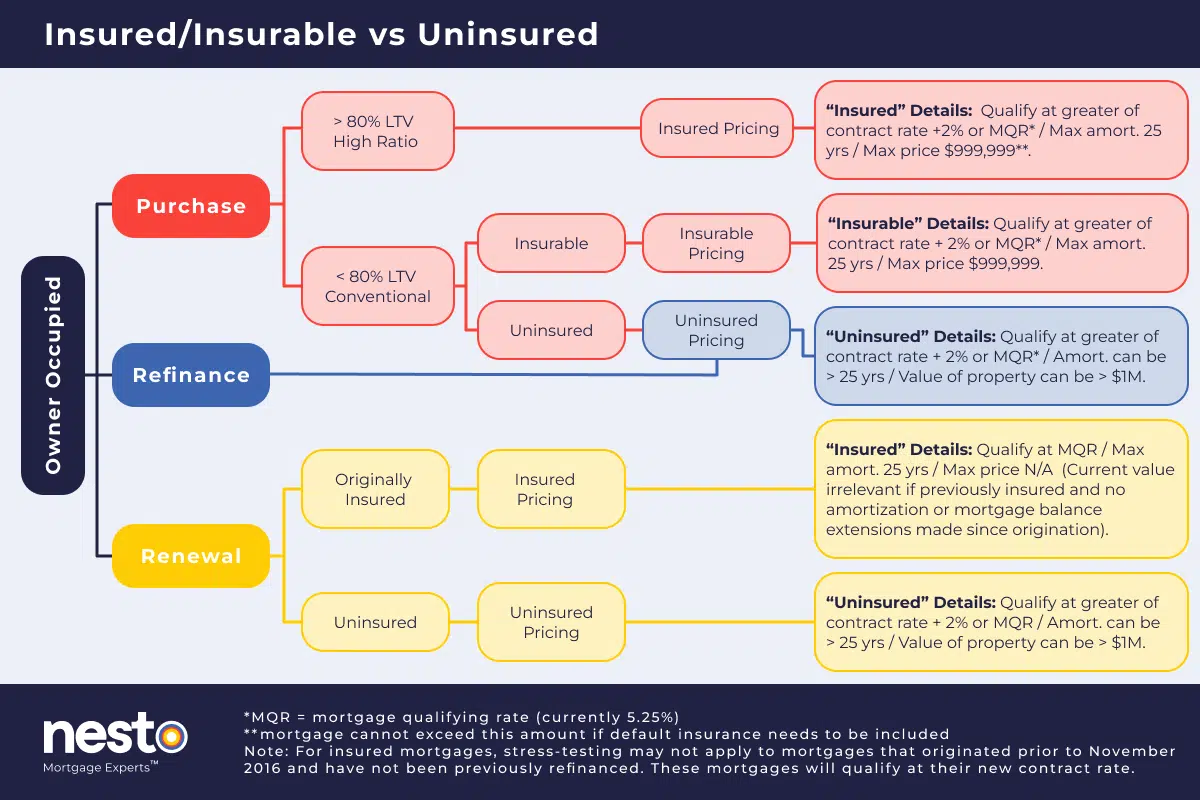
Are you a first-time buyer?
Choosing Between a Mortgage Broker vs. a Mortgage Lender
Mortgage finance companies, mortgage investment corporations (MIC), credit unions, banks, and other federally regulated financial institutions (FRFI) are all different lenders that offer mortgages and underwriting loans.
Lenders
Lenders will have different channels. Some will have branches and brokers that offer their services. In contrast, others will be direct to consumers to avoid the need to give commissions to external salespeople and pass the savings directly to their consumers.
You will need to be aware of which channel you’re working with, as pricing can vary in various channels due to the lender’s need to compensate the salesperson. You’ll also need to understand how the salesperson is being paid and how it affects your mortgage rate.
Mortgage Agents and Brokers
When arranging your mortgage, you should work with a qualified mortgage professional. Unlike a banking advisor who is a generalist, a qualified mortgage professional specializes in mortgages and can provide in-depth insight and knowledge as you go through the application and qualification process.
A qualified mortgage professional can come with various names depending on the province in which they are registered, such as agent, broker, sub-mortgage broker, salesperson or mortgage associate. However, they can provide the same services, must meet the same educational requirements and be provincially regulated. Some provinces, such as Quebec, with its prime directive to protect consumer interests at each stage of the process, have more rigorous education and regulations than all other provinces.
At nesto, our mortgage experts concurrently hold professional designations from one or more provinces. We believe that our clients will receive the best advice and care when they speak with specialists that exceed the industry status quo. Is your mortgage professional licensed?
5-Year vs. 3-Year Fixed Mortgage Rate: Your Comprehensive Guide To Long-Term Cost Savings
Navigating the labyrinthine of mortgage options can feel painstakingly exhausting for many Canadian homebuyers. Among the many choices, deciding between a 3-year fixed-rate mortgage and a 5-year fixed-rate mortgage often leaves borrowers scratching their heads. While both options have benefits and drawbacks, the right choice largely depends on an individual’s financial situation, prospects, risk tolerance and personal economic outlook or opinion.
This comprehensive guide will explore the intricacies of these mortgage terms. How do you decide the path forward? Which one would offer you the biggest savings in the long term? Is there even a wrong choice to make at this moment? This post has answers to all these questions and more.
Key Highlights
- Both 3-year and 5-year fixed-rate mortgages offer unique advantages and challenges.
- Your personal financial goals, market predictions, and risk tolerance should dictate your decision between the two.
- A detailed cost-benefit analysis of various scenarios can clarify the potential outcomes and aid decision-making.
Choosing Between Fixed and Variable Mortgages
Before we deep-dive into the specifics of 3-year and 5-year mortgage terms, it’s crucial to understand the fundamental distinction between fixed and variable mortgages.
- In a fixed-rate mortgage, the interest rate and payment remain constant throughout the term, providing borrowers with stability and predictability.
- On the other hand, in a variable-rate mortgage, the interest rate fluctuates with changes in market interest rates, which can either work in the borrower’s favour or against it.
You should base your choice on your risk appetite, market predictions and short- and long-term financial situation expectations.
Why Opt for a 5-Year Fixed Rate Mortgage?
Historically, the 5-year fixed-rate mortgage has been the go-to choice for many Canadians.
But why is that?
Lenders advertise and discount their 5-year rates more often than other rates they offer, but this option’s primary allure lies in its stability. With a 5-year term, borrowers can enjoy peace of mind with predictable monthly payments.
Stability and predictability can be quite a relief in fluctuating market conditions such as the last 18 months and those forecasted recently by the world’s central bankers. However, this security does come at a cost, as 5-year mortgages lock you in for longer than their 3-year counterparts.
Pros of a 5-Year Fixed Rate Mortgage
- Stability: The fixed interest rate for a 5-year term means your mortgage payments remain unchanged for the entire duration. Stability can be especially beneficial for budgeting purposes.
- Security: The longer-term commitment offers a sense of security, shielding you from sudden changes in interest rates.
- Less Frequent Renegotiation: With a 5-year term, you won’t have to renegotiate your mortgage as frequently, saving you time and potentially money.
Cons of a 5-Year Fixed Rate Mortgage
- Limited Flexibility: A 5-year fixed rate doesn’t offer much flexibility, unlike a 5-year variable rate, which allows for early renewal (conversion) into a fixed rate term equal to the remaining term of your variable mortgage without penalty.
- Risk of Missing Out: If market interest rates fall, you’ll be stuck paying the higher rate until your term ends.
- Higher Penalties: If you must break your mortgage contract early, prepare for a prepayment penalty. Not all penalties are equal; however, some lenders offer a fair and transparent penalty calculation, but not all. Interest rate differential (IRD) penalties on fixed mortgage rates increase when paying out a mortgage with a currently higher rate in a lower rate environment.
The Appeal of a 3-Year Fixed Rate Mortgage
A 3-year fixed-rate mortgage might not be as popular as its 5-year counterpart, but it has gained traction among Canadian borrowers.
The shorter term offers flexibility, making it an attractive option for those with uncertain plans or those predicting a drop in interest rates within 3 years.
Pros of a 3-Year Fixed Rate Mortgage
- Competitive Interest Rates: Historically, lenders have offered slightly lower rates on shorter-term mortgages than 5-year mortgages. However, this relationship has inverted as money markets expect inflationary pressures to subside over the longer term. Every lender’s discount is different, so it’s recommended that borrowers shop around when they come up for renewal before accepting their lender’s first offer.
- Flexibility: With a shorter commitment, you can reassess your financial situation and adjust your mortgage terms more frequently.
- Lower Penalties: If you need to break your mortgage early, the penalties associated with a 3-year fixed mortgage term are typically lower than for longer-term mortgages. This lower penalty allows you to take advantage of sudden life changes, other financial opportunities, or changes in your financial situation.
Cons of a 3-Year Fixed Rate Mortgage
- Less Stability: The shorter term means more frequent exposure to interest rate fluctuations. Many lenders do not offer a discount from their posted rates at renewal time, so you must shop around!
- More Frequent Renegotiations: A 3-year term requires you to renegotiate your mortgage more often, which can be time-consuming and potentially costly.
- Uncertain Future Payments: If market rates rise upon renewal, you could face payment shock with higher mortgage payments.
3-Year vs. 5-Year Mortgages: Which One Is Right for You?
The choice between a 3-year and a 5-year fixed-rate mortgage boils down to your circumstances and financial goals.
- A 5-year fixed-rate mortgage might be your best bet if you desire stability and predictability.
- Conversely, a 3-year fixed-rate mortgage could be the way to go if you prefer flexibility and the potential to benefit from lower interest rates sooner.
However, mortgage rates can fluctuate rapidly and unpredictably depending on the behaviour of the Canadian and US economies and their respective central banks.
Therefore, working with a knowledgeable mortgage expert who can help you navigate the market and select the right mortgage product for your unique needs is advisable. A licensed mortgage expert can also help you compare rates from different lenders to ensure you get the best deal.
In the same vein, going to a lender that offers truly lowest rates as advertised on their website, such as nesto, can prevent you from dealing with a middle salesperson who is not selling their proprietary products. Going directly to a lender avoids any origination fees to the broker or bank mortgage specialist while also avoiding a situation where the broker or bank mortgage specialist recommends a specific product or solution based on the commission or bonus they may earn.
Analyzing the Impact: 3-Year vs. 5-Year Mortgages
To further illustrate the potential implications of your decision, let’s examine 4 hypothetical scenarios to complete a cost-saving analysis and understand your savings if you had to choose between them.
These scenarios and calculations are based on an insured 3-year fixed mortgage rate of 5.74% and an insured 5-year fixed mortgage rate of 5.34%, as advertised on nesto’s website on August 31, 2023. In our sample, we’re using a $350,000 original mortgage balance starting at a 25-year amortization.
During the first 3 years of the mortgage payment comparison, on a rate difference of 40bps (1 basis point is equal to 0.01%) between the 2 options, the guaranteed savings over the first 3 years if one chooses the 5-year fixed mortgage will be $3,913. Your savings can be further broken down as $1,351 in the 1st year, $1,304 in the 2nd year, and $1,258 in the 3rd year, leaving you with a mortgage balance of $314,521.
Now let’s look at what could happen to your costs-savings in the 4th and 5th for different scenarios.
Scenario 1: Rates Drop by 1% in Year 4
In the first scenario, market interest rates drop by 1% in the 4th year and remain the same during the 5th year.
- After 3 years on the 3-year term, you could lock in at a lower rate of 4.74% and save over the 4th and 5th year $3,578 compared to the 5-year rate.
- The total savings amount to $1,821 in the 4th year and $1,757 in the 5th year, leaving you with a mortgage balance of $292,890 at the end of your 5 years.
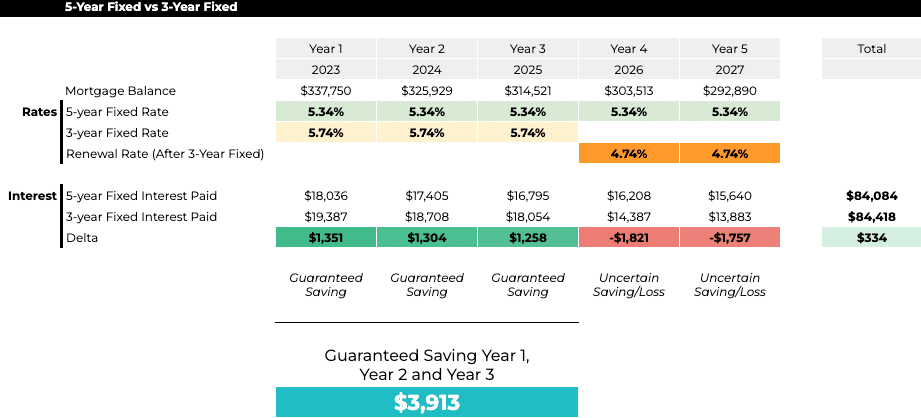
Flexibility is the benefit of choosing a shorter term if you expect mortgage rates to drop in 3 years. However, if you choose the 5-year term, you’d still be left with $334 in guaranteed savings.
If you had chosen the 3-year term, you would have paid $3,913 more in interest over the first 3 years for the chance to save $3,578 more in years 4 or 5.
That is a $3,913 risk you are taking to save or potentially pay a truly unknown interest in years 4 and 5.
Scenario 2: Rates Drop by 1.75% in Year 4
In the second scenario, rates dropped by 1.75% in the 4th year and maintained over the 5th year.
- After the 3 years, you could lock in at a lower rate of 3.99% and potentially save $8,051 in total over the 4th and 5th years over the 5-year rate.
- The total savings amount to $4,097 over the 4th year and $3,954 over the 5th year, leaving you with a mortgage balance of $292,890 at the end of your 5 years.
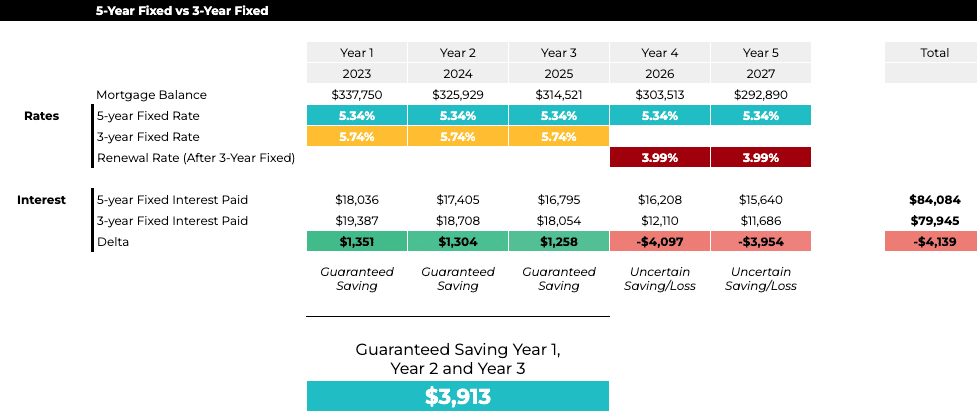
With this scenario, you’d be guaranteed cost savings of $3,913 with the 5-year rate. However, you could expect the flexibility to pay off by locking into a potentially lower rate at the end of your 3rd year, creating a potential cost savings of $4,139 with a higher 3-year rate initially.
If you had chosen the 3-year term, you would have paid $3,913 more in interest over the first 3 years for the chance to save $8,051 more in years 4 or 5.
That is a $3,913 risk you are taking to save or potentially pay a truly unknown interest in years 4 and 5.
Scenario 3: Rates Remain the Same Through End of Term
In the third scenario, rates stay the same til the end of the 5-year term.
- After the 3 years, you lock into the same 5.74% rate and produce total savings of $2,386 over the 4th and 5th year on the 5-year rate over the 3-year rate.
- The total savings amount to $1,214 over the 4th year and $1,172 over the 5th year, leaving you with a mortgage balance of $292,890 at the end of your 5 years.
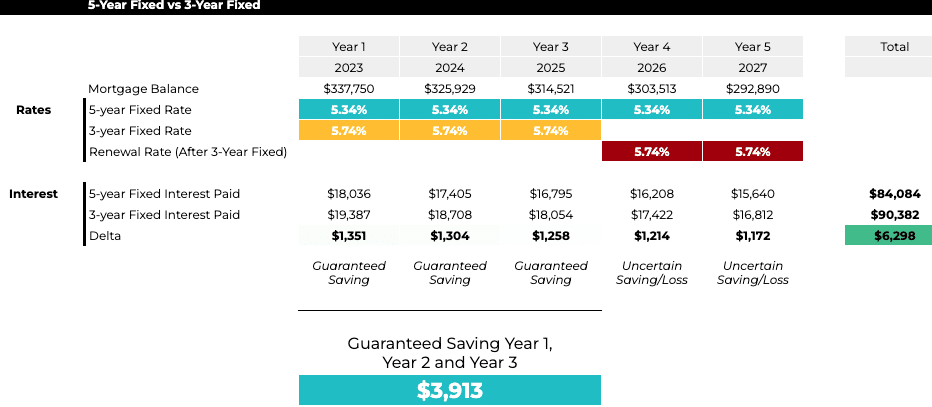
With this scenario, you would not expect the flexibility to pay off by locking into a similar rate at the end of your 3rd year, creating a guaranteed savings of $6,298 by choosing the 5-year rate.
If you had chosen the 3-year term, you would have paid $3,913 more in interest over the first 3 years for the chance to pay another $2,306 more in years 4 or 5.
That is a $3,913 risk that you are taking to save or potentially pay a truly unknown interest in years 4 and 5.
Scenario 4: Rates Increase by 1% in Year 4
In our last scenario, rates increased by 1% in the 4th year and maintained over the 5th year.
- After the 3 years, you would need to lock into a higher rate, which would produce a total savings of $8,349 over the 4th and 5th year on the 5-year rate compared to the 3-year rate.
- The total savings would amount to $4,249 over the 4th year and $4,100 over the 5th year, leaving you with a mortgage balance of $292,890 at the end of your 5 years.
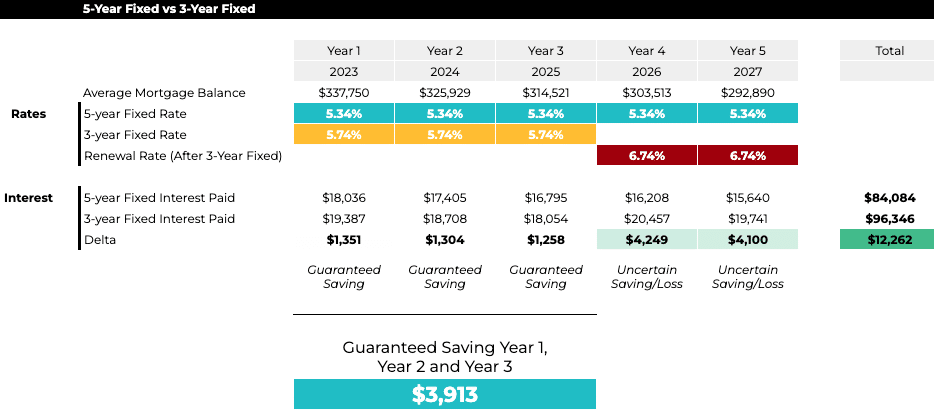
With this scenario, you expect the stability to pay off by locking into the 5-year rate, creating a guaranteed savings of $12,262 by choosing the 5-year rate.
If you had chosen the 3-year term, you would have paid $3,913 more in interest over the first 3 years for the chance to pay another $8,349 more in years 4 or 5.
That is a $3,913 risk that you are taking to save or potentially pay a truly unknown interest in years 4 and 5.
We hope these scenarios have illustrated our point that locking into an extended period offers stability and predictability for a longer period when rates are expected to rise. However, locking into a shorter term provides flexibility and savings if rates are expected to decrease by more than 1% over the term.
FAQs on 3-Year vs. 5-Year Mortgage Savings
Is it better to get a 3-year or 5-year mortgage?
The better choice depends on your circumstances, prospects, and risk tolerance. A 3-year mortgage offers greater flexibility and potential savings if interest rates drop, while a 5-year mortgage provides stability and protection against rising rates.
Which mortgage term length is better when interest rates increase?
If you anticipate a rise in interest rates, a 5-year fixed-rate mortgage might be more beneficial. The longer you lock into your interest rate, the more protection you have from potential rate increases.
Which mortgage term length is better when interest rates decrease?
If interest rates are expected to decrease soon, a 3-year fixed-rate mortgage would be better. This shorter-term commitment allows you the flexibility to take advantage of lower rates sooner.
Find a better rate, and we’ll match it, beat it, or give you $500*.
*Conditions Apply
With nesto, it’s stress-free
Final Thoughts
Choosing between a 3-year and a 5-year fixed-rate mortgage isn’t a one-size-fits-all decision. It depends on various factors, including your financial situation, plans, and risk tolerance. It is recommended that you get professional and knowledgeable advice from a licensed mortgage expert.
Mortgage experts can provide advice tailored to your unique circumstances and help you navigate the complex world of mortgages. Remember, informed decisions make for better long-term financial health.
If you’re renewing your mortgage or buying your first home, contact nesto’s mortgage experts to find the most suitable mortgage and rate for your situation. Reach out today, and we’ll connect you with one of our mortgage experts to answer all your questions.
Ready to get started?
In just a few clicks, you can see our current rates. Then apply for your mortgage online in minutes!


